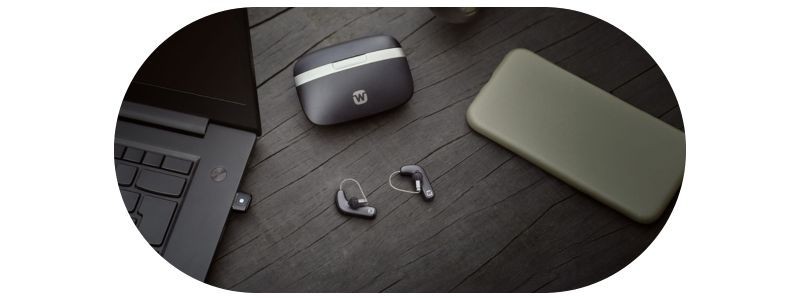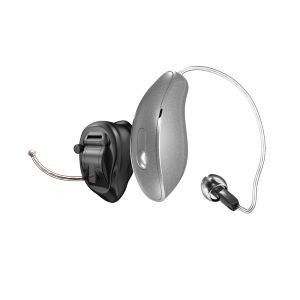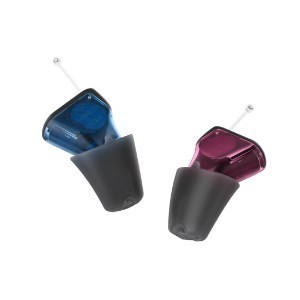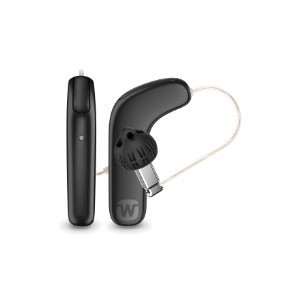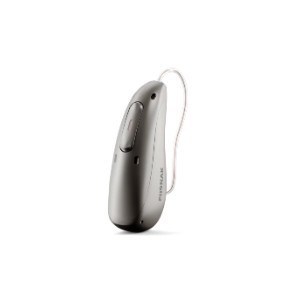Top 5 Best Hearing Aids of 2025 by Our Audiologists
What are the best hearing aids in the UK for 2025?
This best hearing aid review article was last updated on 17/04/2025
Looking for a hearing aid to buy?
You might be looking for the best hearing aids and have looked at some in-store options locally. You are now wondering if it is worth upgrading your hearing aids yet, but it all depends on what you buy.
2024 brought significant advances in digital hearing aid technology, such as new Bluetooth ITE options, the world's first waterproof rechargeable aid, and a heart rate sensor. Other hearing aid makes have barely improved in years.
2025 is set to bring even more to the industry, particularly in design. As technology advances, so does aesthetics. The newest hearing aids have shown a slimmer and more discreet casing. However, the best hearing aids available in the UK are subjective.
If you are looking for the best hearing aids money can buy or not - either way, we hope this guide will help you in your search to find the right hearing aid for you - whether that be the upgrade you need or if you are wearing new hearing aids for the first time.
Choosing the best hearing aids in the UK
To label the industry's best hearing aids of 2025 in numerous categories, we asked our audiologists to score each hearing aid on the market using such criteria as hearing aid prices, hearing aid features, technology advancements, and other priorities that are generally considered important to consumers regarding hearing aid comparisons.
What are the top five rated hearing aids? Find out with our review of the best hearing aids available in the UK for hearing aid users in 2025 below.
Best hearing aids for 2025
- Oticon Intent
- Starkey Edge AI
- Signia Silk IX
- Widex SmartRIC
- Phonak Infinio Sphere
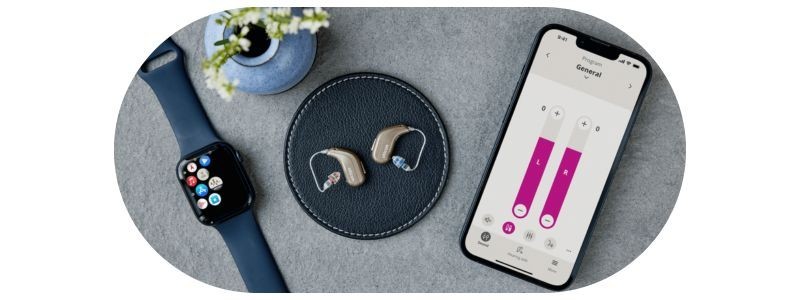
Best Hearing Aids 2025, Reviews and Hearing Aids Comparison
Including the best hearing aids and prices in the UK
The Best Hearing Aids of 2025 Winner
Oticon Intent 1 hearing aids
So, are Oticon the best hearing aids? In March 2023, the predecessor of this aid, the Oticon Real 1 hearing aid was considered by many to be the best hearing aid on the market.
In February 2024 they launched the new generation - the Oticon Intent 1. It's even better and is the reason why we have voted Oticon Intent as the best overall hearing aid.
In fact, it is arguably going to be one of the most popular hearing aids in the world, just like Real was.
Precision in sound processing
The top performance level, Oticon Intent 1 hearing aid, gives you the most precision in sound processing, more customisation in your background noise, and premium noise reduction.
Intent also introduced the new 4D sensor technology which allows these hearing aids to learn from your head and body movements and adapt your soundscape accordingly. Ultimately giving you an even better speech understanding in noise.
Any improvements since Oticon Real?
- There is a new Sirius processing chip and Deep Neural Network 2.0 (DNN) that all contribute to Oticon Intent's better sound quality, speech clarity, and efficiency in noise suppression.
- There's been an improvement in frequency response from 80 Hz to 10 kHz. Theoretically, this should mean you'll benefit from a richer sound experience than you would with Oticon Real.
![]()
- The new MoreSound intelligence technology and next-generation MoreSound Amplifier 3.0 offer reduced base noise along with better high-frequency response and dynamic range. This could potentially rival the likes of Starkey Genesis AI.
- Oticon Real introduced one of the best feedback suppression algorithms, however, Intent takes this further with an even smarter algorithm to control feedback. This is all made possible without compromising on speech understanding or sound quality.
- The new style of miniRITE is smaller than Real and the sized 13 battery means there is around 33% more charge on the go. Plus, the Intent is future-proof with Bluetooth LE Audio and Auracast.
- Read all about our comparisons between Oticon Intent and Real in our article here

Why buy Oticon Intent?
Sound handling
What makes Intent one of our best hearing aids? It's the way these hearing aids simply handle sounds. Instead of doing what other hearing aids do - suppressing background noise and focusing on speech, Intent offers a more natural and full soundscape to the brain.
The 4D sensor technology means these hearing aids learn from your head and body movements and adapt your soundscape accordingly so you can benefit from better speech understanding in noise.
Oticon states that premium hearing is more than just sound. Understanding the wearer is also an important part of someone's listening experience.
Different hearing loss levels need unique support and even though two people with hearing loss can be in the same listening environment, they both need their hearing aids to work differently.
In theory, Intent understands your listening intention, therefore you will enjoy truly personalised hearing that deals with your distinct requirements.
Intent, in our opinion
- Oticon Intent 1 hearing aids give you one of the most powerful platforms on the market (Sirius). It has pretty much closed a lot of gaps in Oticon Real and is going to make a real difference when hearing in challenging environments.
- With technologies such as 4D supporting you better in communication and engagement and MoreSound giving you access to a more accurate interpretation of sound in the brain, a richer representation of your environment, and a bigger scope of all sounds – we predict this digital hearing aid will be hard to beat.
- Oticon Intent is a small hearing aid, so it will sit comfortably on the ear.
![]()
- At launch, like the Real, Intent includes the only artificial intelligence that greatly improves speech understanding with their Deep Neural Network technology. Giving you the most advanced and best hearing aids for artificial intelligence.
- If you are drawn to the idea of hearing more of the sounds around you instead of just focusing on speech - this hearing aid is a great choice.
- For those who suffer from Tinnitus, Intent's Tinnitus SoundSupport is a really good sound generator that is easy to use. You can set it to play sounds, such as white noise, to reduce the effect of tinnitus symptoms.
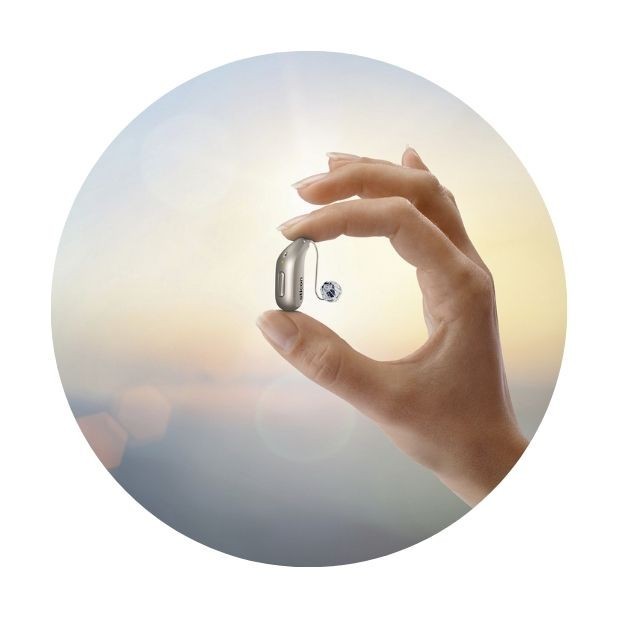
Why not buy Oticon Intent?
- Oticon Intent hearing aids were launched without In-Ear products. If you are looking for this type of hearing aid, and you like Oticon's open sound, check out the custom Oticon Own which includes the older More technology.
- These hearing aids are rechargeable and carry a premium price tag. If budget is a priority or your hearing loss is milder, you might want to look at other hearing aid brands or consider Zircon, Oticon's essential line.
#1 Best hearing aids features at a glance
Styles available: Receiver in Canal (RIC)
Models available: Intent miniRITE R (this is the only model available in this range)
Bluetooth connectivity: Yes
Rechargeable options: Yes
Fitting range: Different receiver power levels
Smartphone compatibility: Android and iPhone
Technology levels: 1, 2, 3 and 4
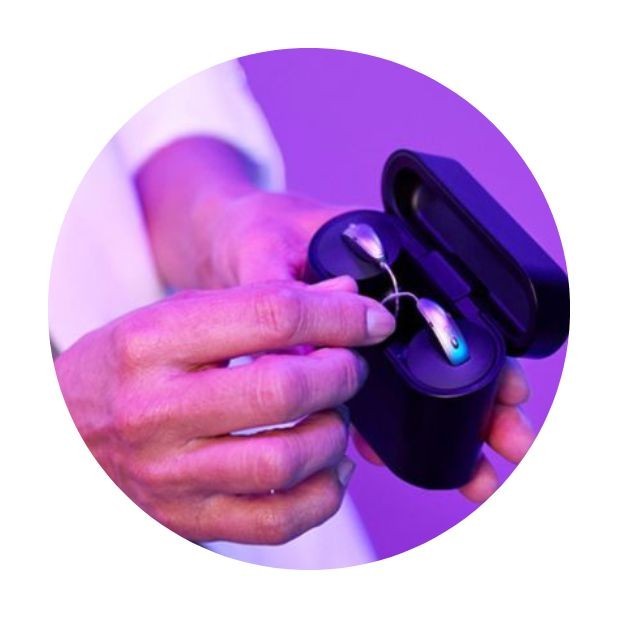
The Best Hearing Aids of 2025 Second Place
Starkey Edge AI 24 hearing aids
What makes Edge AI one of our best hearing aids? Starkey Edge AI 24 wins second place for pure innovation and for providing great product support and improvements since the Livio was introduced.
Launching in October 2024, Edge AI is their fourth-generation rechargeable custom-made hearing aid with a variety of other sensors and functions from foreign language translators to heart rate monitors.
However, the main goal for Starkey Edge AI hearing aids was to create an entirely new platform, with a particular focus on incorporating artificial intelligence (AI) to enhance background noise management and enable users to operate their hearing aids using voice commands.
G2 Neuro Processor
However, what really impressed us was the platform's G2 Neuro Processor. The Edge AI offers crisp speech clarity, while the My Starkey app adds a unique mix of customisation and health features.
Edge AI looks identical to the previous Genesis AI models but includes subtle upgrades that will likely appeal to those seeking advanced, super smart hearing aid technology.
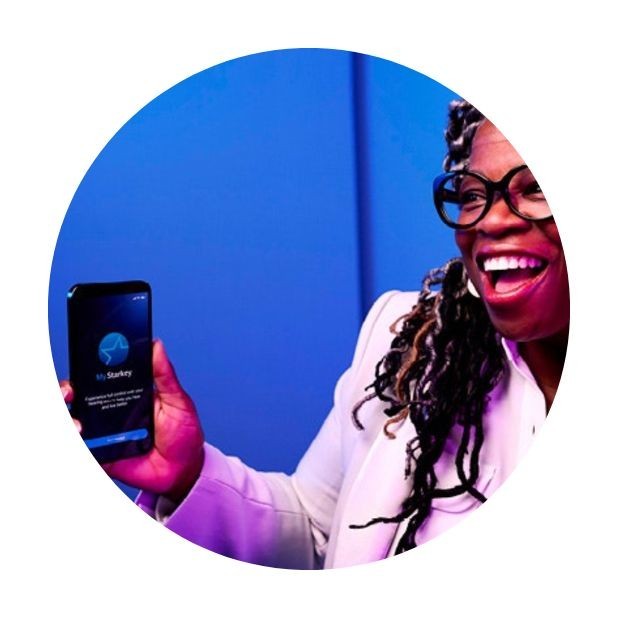
Why buy the Starkey Edge AI 24?
Feature-rich hearing aid
Unlike some of Starkey’s competitors, Edge AI integrates its Deep Neural Network (DNN) directly into the main processing unit. This technology, trained on millions of sound environments, delivers exceptional speech-in-noise performance, providing an impressive 13 dB improvement in noisy situations.
While rechargeable batteries are becoming the standard, Starkey continues to offer models with traditional disposable batteries, giving users more choices based on their preferences.
Edge AI supports Bluetooth Low Energy (LE) Audio, enabling smooth audio streaming, hands-free calls, and multi-device connections with both iOS and compatible Android devices. It’s also Auracast ready, awaiting a future firmware update.
These hearing aids boast an IP68 rating, offering the highest level of protection against dust and moisture. Starkey has also subjected them to rigorous durability tests to ensure long-lasting performance.
Edge AI, in our opinion
- Starkey offers a variety of styles to match your preferences and hearing requirements.
- Starkey includes a telecoil option in several Edge AI models, ensuring clearer audio at looped venues.
- The My Starkey app is one of the most comprehensive hearing aid apps on the market, offering features like health tracking, fall alerts, real-time translation, transcription, and more.
- With the My Starkey app, you can also connect with your audiologist for virtual telehealth sessions, making it convenient to schedule follow-ups and adjust settings remotely.
- Easily control your Edge AI devices wirelessly using the My Starkey app, which is also compatible with Apple Watch for added convenience.
- Edge AI offers a remarkable 51 hours of battery life per charge, comfortably lasting through even the busiest days. Actual battery performance may vary depending on streaming use, battery age, and other factors.
- Edge AI is compatible with a variety of Starkey accessories, giving users more options for streaming, remote microphones, and wireless controls.
- The charger, while not groundbreaking, is solid, dependable, and easy to use, perfect for hassle-free daily charging.

Why not buy the Starkey Edge AI 24?
- This hearing aid has more tech than other brand offerings, but that's only if you think you'll use all these features. You might want all the bells and whistles that this Starkey hearing aid range has to offer, but then again don't pay for what you don't need.
- The Edge AI model is more expensive than other hearing aids of its ilk, so make sure you will get good use out of the extra features.
#2 Best hearing aids features at a glance
Styles available: Receiver-in-Canal (RIC), In-the-Ear (ITE), In-the-Canal (ITC), and Completely-in-the-Canal (CIC).
Models available: CIC, ITC R, ITE R, RIC 312, RIC RT, and mRIC R
Bluetooth connectivity: Yes
Rechargeable options: Yes
Fitting range: Various fitting options
Smartphone compatibility: Android and iPhone
Technology levels: 24, 20 and 16
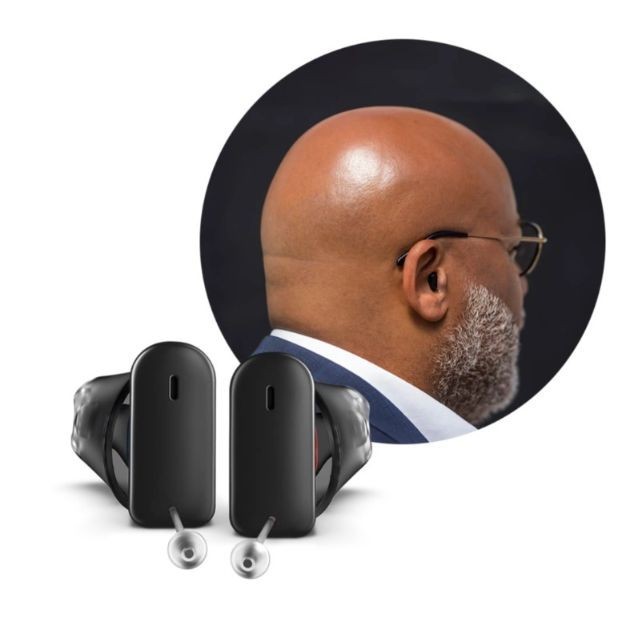
The Best Hearing Aids of 2025 Third Place
Signia Silk 7IX Charge&Go hearing aids
Why is Silk one of our best hearing aids? The Signia Silk 7IX Charge&Go model is a "modular CIC", which means it is a Completely in the Canal (CIC) hearing aid. Very hard to see on most people and includes the new Integrated Xperience platform.
It does not need to be custom-made to the shape of the ear and does not block the ear canal in the same way either.
The Silk was sadly missed in the AX hearing aid platform so this new generation model was long overdue. Plus, at launch in September 2023, the world's first CIC rechargeable hearing aid with Binaural OneMic Directionality for focus in noise.
Best small hearing aids
The beauty of this hearing aid is down to the great design which allows those who require an open fitting to still wear a CIC. You might have been told that you can't wear an in-ear hearing aid. The good news here is that you might be able to wear this one.
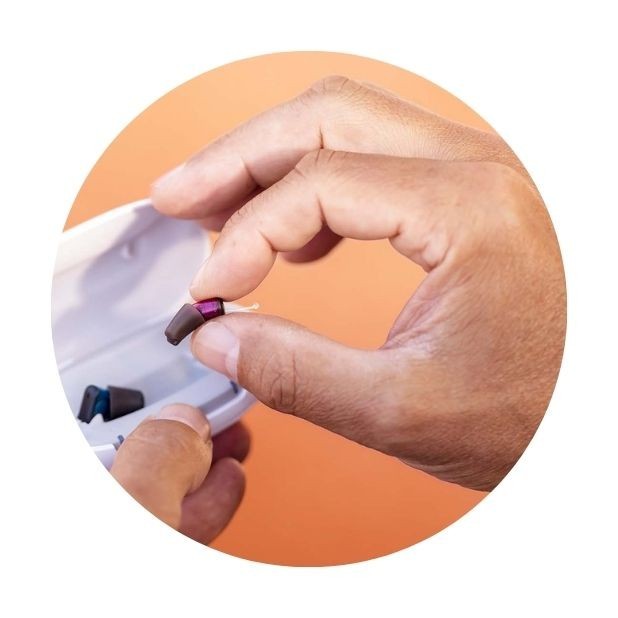
Why buy the Signia Silk 7IX Charge&Go?
- Has the same great quality processing as you get in the Behind-the-Ear Signia 7IX hearing aids - giving you a clear and natural sound.
- You can use the user-friendly Signia app to fine-tune your hearing aids with your audiologist remotely.
- They have a CROS system in both BTE and ITE, which is unusual, as people with this type of hearing loss cannot usually get discreet in-ear aids.
- Comfortable and open-fitting rechargeable IIC with a pocket power bank offering four extra charges wirelessly.
- If you’re looking for a completely programmable, high-end, and invisible hearing aid option but don’t want to go down the custom mould path, Signia Silk IX is worth considering.
- If you travel often or spend time socialising, then this performance level will probably be worth the extra.
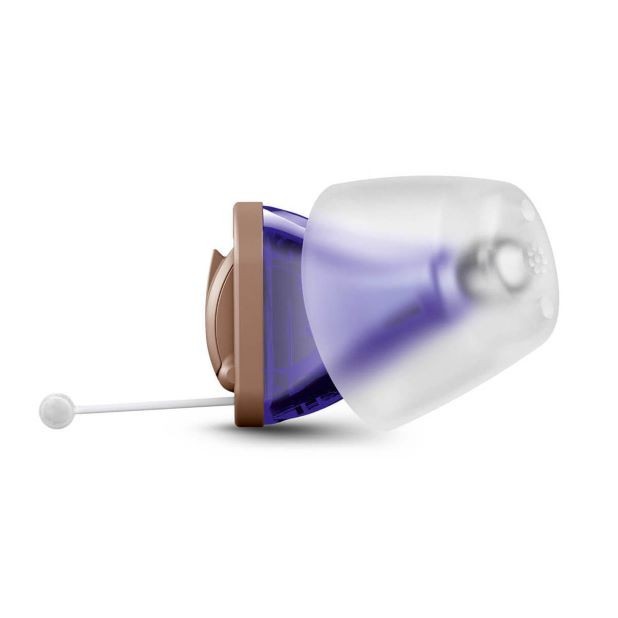
Why not buy the Signia 7IX Charge&Go?
In regards to loss, Signia Silk is great for people with mild-to-moderate hearing and will not be for those with a more profound hearing loss.
On another note, this hearing aid isn't suitable for everybody's ear shape. Therefore, please contact us as we would need to check your ear canal shape.
#3 Best hearing aids features at a glance
Styles available: CIC
Models available: CIC
Bluetooth connectivity: No
Rechargeable options: Yes
Fitting range: Instant fit
Smartphone compatibility: Android and iPhone
Technology levels: 7, 5 and 3

The Best Hearing Aids of 2025 Runner Up
Widex SmartRIC 440 hearing aids
If you're new to hearing aids, these devices are worth considering. Widex has carved out a niche in the market with its unique style. The Widex SmartRIC showcases this, being one of the smallest rechargeable hearing aids available, fitting sleekly behind the ear.
Despite its compact size, the SmartRIC 440 still offers advanced technology and powerful performance, even though it dates back to 2022. Those who usually prefer in-ear products or are seeking innovative charging solutions might find these particularly appealing.
Full scope of sound processing features
The 440 is the premium technology level in the range and offers full sound processing features, such as wind noise reduction, speech enhancement, 15 adjustment bands for sound personalisation, and 11 background sound analysis settings (used by your audiologist).
They are ideal for regular travellers, for those who socialise often, and for those who have mild to severe hearing loss.
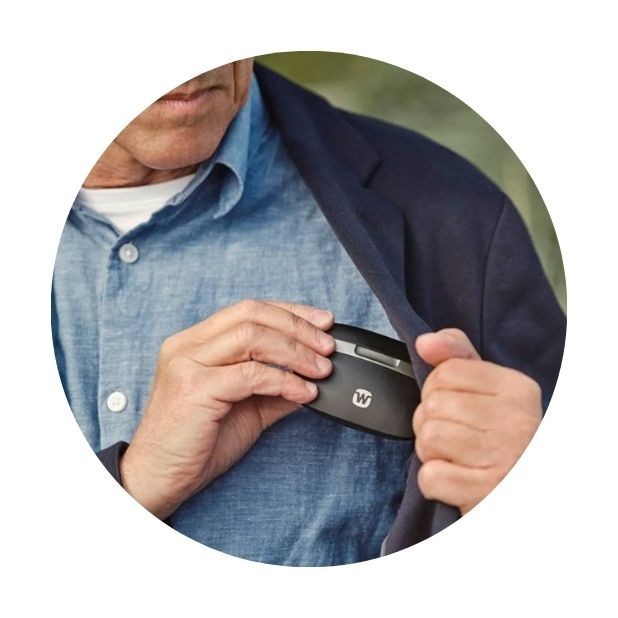
Why buy the Widex SmartRIC 440?
Advanced aesthetics
Why is SmartRIC one of our best hearing aids? If you're a loyal Widex wearer, you'll likely love the new shape. If you haven't upgraded since the Widex Moment platforms, you might want to consider investing in a pair of these.
For those already using the Widex Moment Sheer and prioritising aesthetics, upgrading to the SmartRIC is worth considering but, overall, SmartRIC uses the same technology (with a few subtle improvements). Read all about Moment Sheer vs SmartRIC in our article here
The Widex SmartRIC is also a really good tinnitus hearing aid. It's arguably the best hearing aid for tinnitus.
This feature uses fractal musical tones to manage tinnitus, which is good because they are played at random and, therefore, there is no pattern for your brain to habituate.
The Widex SmartRIC also uses the amplification of natural sounds of nature to relieve the symptoms of tinnitus. Even if you don't have tinnitus, you'll find this feature will give you focus and a sense of relaxation that will reduce any forms of listening fatigue.
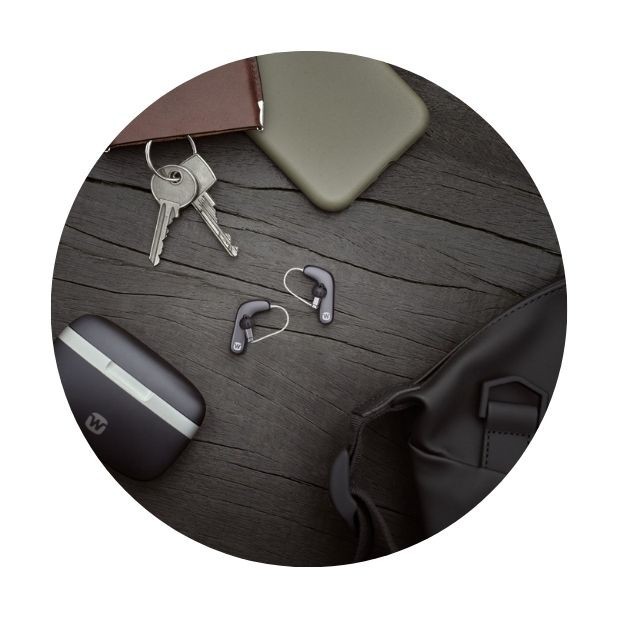
Why not buy the Widex SmartRIC 440?
Don't buy this hearing aid because Widex has claimed it "doesn't sound like a hearing aid" and is not 'tinny' or artificial like other hearing aids. The ‘tinny’ sound Widex is referring to is a generalisation. In reality, people can rarely detect digital echo in aids.
Most of our customers who have worn Widex aids can’t detect the difference in speed from their previous devices. However, they have enjoyed the natural sound quality - so they must be doing something right!
If you are looking for the smartest hearing aid tech or longest-lasting battery out there, then you might consider other alternatives. There are also no disposable battery models and they might be out of budget for some.
#4 Best hearing aids features at a glance
Styles available: Receiver in Canal (RIC)
Bluetooth connectivity: Yes
Fitting range: Supporting S and M receivers
Rechargeable options: Yes
Smartphone compatibility: Android and iPhone
Technology levels: 440, 330, 220 and 110
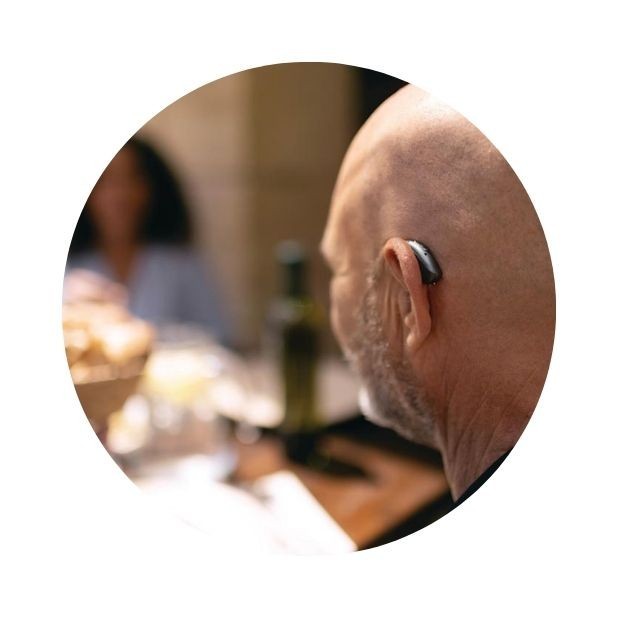
The Best Hearing Aids of 2025 Runner Up
Phonak Infinio Sphere i90 hearing aids
Why is Phonak Audeo Infinio Sphere one of our best hearing aids? You only need to take a look at the improvements in filtering out background noise to see why this Phonak model has made it onto our best list. So, why should you consider purchasing them?
These aids are built with a separate computer chip, Deep Sonic, created to divide the speech you actually want to hear amongst the annoyance of background noise.
Ultimately, speech is cleaned up from noise using AI technology, called deep neural network (DNN), giving you great speech in noise processing.
Also, it is worth noting that the new chip will only function for three hours in background noise unless the audiologist overrides the limiter as the battery drain is so high from the AI chip.
Why buy the Phonak Infinio Sphere i90?
Speech in noise performance
Why is this important to you, as a wearer? It's not just a world's first (at launch), it actually works really well in day-to-day listening scenarios. When compared to other aids of a similar ilk, Infinio Sphere offers a 10 dB signal-to-noise ratio improvement and around 36% better speech understanding in busy listening environments.
This AI feature will support and reduce your everyday hearing difficulties, and effectively fine-tune your aids to work with each tricky environment you find yourself in. For example, if you're in a noisy restaurant, this feature will support clearer speech understanding and reduce background noise, making conversations simply more enjoyable.
Over time, and as the AI feature learns, you'll be provided with a more personalised listening experience.
Adaptability
Phonak's new AutoSense 6.0 is another welcome new feature and arguably one of the best adaptive programs currently available. Designed to consistently analyse your acoustic environment and adjust accordingly in real-time to enhance your sound's comfort and clarity.
It also categorises key wearer environments, such as Speech in Car, Music, and Comfort in Noise and, at fitting, your audiologist will program how your hearing aids react in each environment and adjust them to suit your hearing loss needs.
Overall, this means you should get enhanced speech understanding and reduced listening effort, making it easier to focus on your conversations. Thus, giving your ears the freedom to hear more and comprehend the context within sentences spoken as there will be less focus on lip reading and other visual queues.
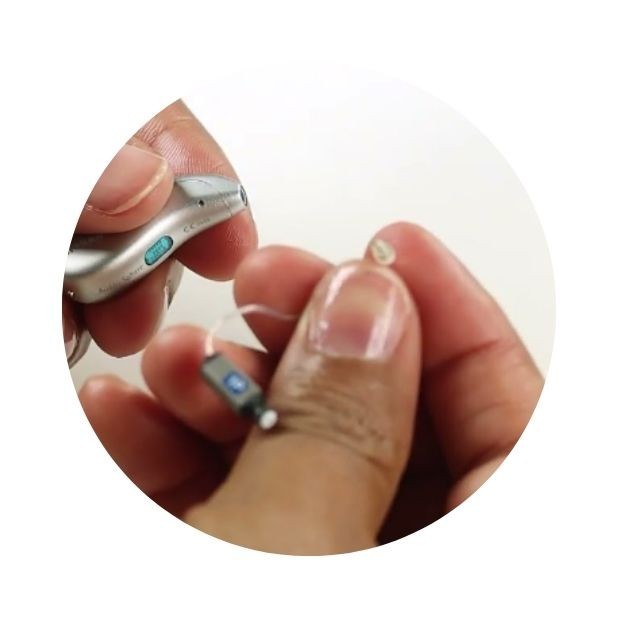
Bluetooth connectivity
Phonak's connectivity has always been pretty good, offering classic Bluetooth to connect to any wireless source, such as mobiles, tablets, and computers.
Their aids also support dual streaming, so you can connect to multiple devices at the same time, not possible by any other hearing aid brands so far.
With the Infinio Sphere launch, hands-free calls are supported and the transmission power since their older models has improved, now giving you a more stable connection.
What does a better connection mean? It simply means you will benefit from quality audio and connectivity over longer distances and seamless transitions when switching from different audio sources.
LE Audio has been introduced with this range, so your aids will be Auracast-ready and effectively future-proof. Although this might mean nothing to you now, as Auracast transmitters are pending and this connectivity is not activated in the devices.
It will be rolling out over the next few years. We predict this will be a free firmware update with your audiologist when the time is right.
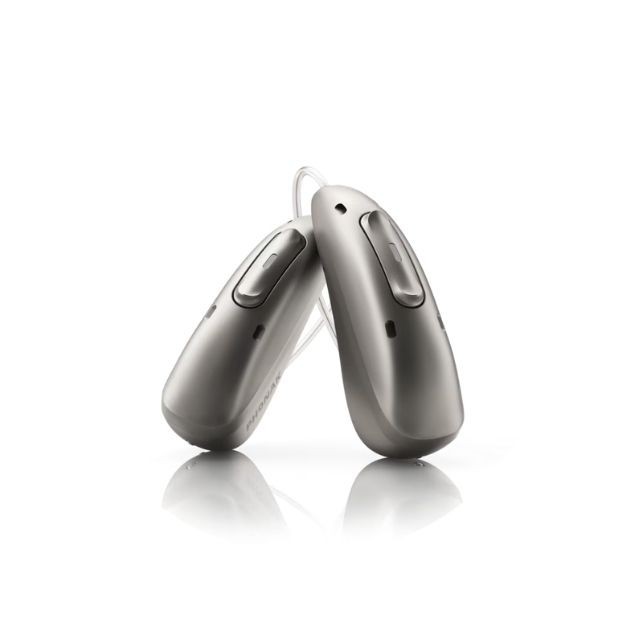
Why not buy the Phonak Infinio Sphere i90?
Size
When looking at the size, they do fall on the larger side. I don't think this is an issue when you look at the technology onboard, however, it may still put some wearers off.
I also think Behind-Ear wearers aren't racing for the smallest hearing aids on the market as much as they used to be, especially when the smaller RIC devices may come at a cost for functionality.
This means potentially losing out on connectivity, rechargeability, enhanced clarity, and noise reduction features. Speak to your audiologist, and weigh up the pros and cons of Sphere with your unique specifications in mind. Is size more important than tech?
Battery performance
There's also the battery to consider. In short, if your Sphere hearing aids are switched on to their AutoSense feature and adapting to your listening environments, along with a more balanced lifestyle, then the battery should last you all day.
However, if you switch on your AI Spherical Speech in Noise, it means your speech in loud noise is consistently on. This has the potential to reduce your battery life significantly which might cause problems on a day-to-day basis. You can read our article comparing Phonak Lumity with Infinio, including the Sphere model, here
#5 Best hearing aids features at a glance
Styles available: Receiver in Canal (RIC)
Models available: Infinio Sphere R
Bluetooth connectivity: Yes
Fitting range: Includes an ActiveVent option
Rechargeable options: Yes
Smartphone compatibility: Android and iPhone
Technology levels: i90, i70
What's included in our hearing aid prices?
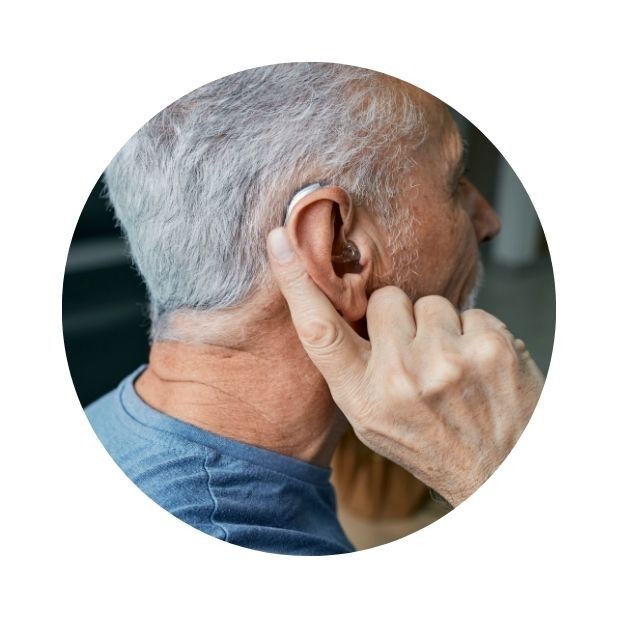
Compare the best hearing aids for the money
The best hearing aids reviews UK
You may be wondering how to find the best rated hearing aids for you or which hearing aids are the most beneficial for you and your hearing loss - either way, it can become an overwhelming experience for some.
When you compare hearing aids online, it can all get rather confusing, especially when some hearing aid providers aren't transparent with their pricing. That being said, hearing aid comparisons are a great place to start.
If you are on the hunt for a hearing aid, finding the right hearing aid type and style depends on your level of hearing loss, lifestyle, aesthetic preferences, and other priorities.
However, investing in hearing aid devices doesn't necessarily mean you have to purchase the best hearing aids you can buy.

What about hearing aids in the UK?
Where to buy the best hearing aids locally
Where you purchase your hearing aids is important too. For instance, whether you opt for private hearing healthcare and hearing aids or choose to go with the NHS is entirely down to personal choice.
However, seeing a private audiologist will give you access to a wider range of hearing aid brands, types, and styles as well as a more personalised hearing experience.
If you decide to go with the NHS or buy Over-the-Counter (OTC) hearing aids online - you will find yourself with limitations in device, type, style, connectivity, and customisation.
This is why researching hearing aid companies, brands, and prices is a valuable first step.

Private hearing healthcare offers the latest hearing aid technology and advanced hearing aids
What are the best hearing aids locally? When researching hearing aids shops near you and where you'll get the best hearing aids to buy, the best service, and the best aftercare - you only have to look at the Which? Report.
This report states, year after year, that independent companies, like us, come out on top for hearing aid providers in the UK and the best place to get your devices from.
Hearing aid suppliers and independent audiologists like Hearing Aid UK can advise on the best hearing aid for your hearing loss from the best hearing aid brands in the industry. We can also provide the best digital hearing aid accessories from all of the brands if needed.
However, unlike most other hearing aid companies, our range is not limited. This is because we are not owned or affiliated with any of the manufacturers, so we are able to offer the full range of hearing aids without prejudice.
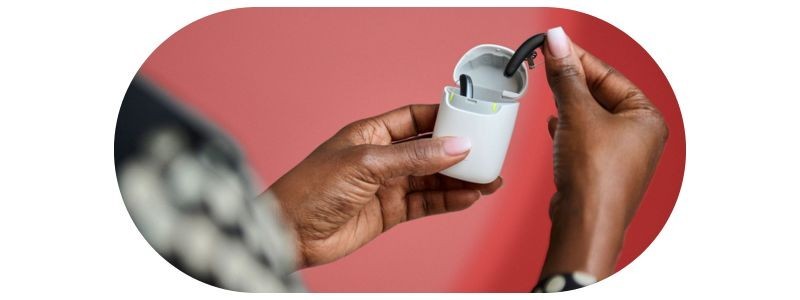
What are the best hearing aid styles for me?
How to get started finding the right style for you
Do you already wear hearing aids?
If you are already wearing hearing aids and looking to upgrade them, most of our customers start with a similar style to what they are used to and have already. This means you are more aware of the device and you can adjust quickly but now benefit from the new and more modern features.
You must always have your hearing tested again before upgrading your hearing aids, as over time your hearing can change and you may have different priorities and hearing needs.
However, priority should always be the best product for better hearing and if you have had your hearing aids for around 3-4 years - there will almost definitely be advanced hearing technology that will serve your hearing loss better.
What are your hearing needs and cosmetic preferences?
It is best to understand your specific hearing requirements. Do you struggle with conversations in noisy environments, or do you need help primarily in quiet settings? Different hearing aids excel in different situations.
Consult with an audiologist or hearing healthcare professional for a thorough hearing evaluation. This test will reveal the extent and type of your hearing loss, which is crucial in choosing the best hearing aid.
Some people prioritise discreetness, while others may not mind a more noticeable device. Modern hearing aids come in various styles, including Behind-the-Ear (BTE), In-the-Ear (ITE), and Invisible-in-Canal (IIC), among others.
Do you have dexterity concerns?
If you have dexterity problems, smaller hearing aids might be a challenge for you. Low-profile In the Ear hearing aids or Behind the Ear (BTE) options might be easier to handle. The batteries are also bigger, so these will be easier to change too.
You might even want to consider rechargeable hearing aids - which require no battery changes at all. Hearing aids with automation might be beneficial as there are no tiny buttons you have to press on the device to adjust such settings as volume.
Do you lead an active lifestyle?
If your activities are limited, you are homebound or require care support - Behind the Ear (BTE) hearing aids might be more practical. This is because they can include earmolds that are easier to fit comfortably in the ear and can easily be managed by a care support worker. In such lifestyle situations, you might want to consider assistive listening devices for some extra amplification for TV programs or doorbells.
On the other hand, if you lead an active lifestyle - there are now plenty of 'healthable' hearing aids on the market providing additional features, such as fitness tracking or heart monitoring designed to enhance and keep up with your lifestyle.
What is your hearing loss level?
For your hearing aids to be successful - the actual fit and acoustic compatibility, done at your programming and fitting appointment, is the most important. This is often called the best first-fit experience by audiologists.
In short, your actual fit is how the hearing aid fits in your ear which can ultimately affect the way you hear and whether you are comfortable wearing it or not. The acoustic fit is how your device settings are catered for your individual hearing needs by your audiologist.
For example, if you have low-frequency hearing loss, a comfortable and snug fit of a Completely in the Canal or In the Canal hearing aid style would help process sound while remaining discreet. The occlusion will also help stop unwanted background noise.
What is your budget?
There are also hearing aid technology levels to consider. These are generally basic, standard, and premium - and like with all technology the more sophisticated the technology the more you will pay for your devices.
A good audiologist will show you the latest hearing aids that are available, talk through the hearing aid's new features of the industry, and discuss the features versus benefits with you with your hearing loss level in mind.
An audiologist will also advise on the best technology level for your hearing loss, as you shouldn't have to pay for more than you need and for features you won't use. Hearing aids vary in cost, and insurance coverage may be a factor. Discuss your budget with your audiologist to explore options within your price range.
How much are hearing aids?
How much do hearing aids cost? Understanding hearing aid prices and costs in the UK is essential for those seeking better hearing. The cost of hearing aids can vary widely based on factors like technology level, brand, and additional hearing healthcare services. Our prices start from £695 per aid.
Basic hearing aid models are more budget-friendly, while advanced, feature-rich options come at a premium. In the UK, prices typically include services like hearing tests, fitting, and follow-up care - adding to the overall expense. Hearing aid accessory choices and ongoing maintenance can also affect the final hearing aid cost.

Best Hearing Aids of 2025
Other information about the best hearing aid devices you might find useful
What would you like to know more about?
Below are some quick links to information that can answer a few common questions we often get from patients. Such as the disadvantages of buying a hearing aid online, what is a hearing aid, what are the most powerful hearing aids, what are the most discreet hearing aids, or which type of hearing aid is the least expensive.
The best private hearing aids and healthcare for 2025
Researching the best hearing aids for 2025 and need more support? This report replaces our last review, "best hearing aids 2024". We endeavour to edit this content accordingly as and when there are more advanced models available.
If you are researching the best place for hearing aids or the best hearing aids in the UK and want impartial, independent advice then you’ve come to the right place.
To compare our prices and services or for other hearing healthcare support - call us free on 0800 567 7621 to speak with one of our audiologists.
Why choose Hearing Aid UK to help you find the best hearing aids for you?
Our specialist service includes:
Do not spend hundreds of pounds without getting a second opinion from us.
Please call us on 0800 567 7621
 Not only are the prices great, but the service is fantastic! Many thanks to your team.
Not only are the prices great, but the service is fantastic! Many thanks to your team.Discover the best digital hearing aids in 2025
Common FAQs about the best hearing aids for 2025
If you have dexterity problems, smaller hearing aids might be a challenge for you. Low-profile In the Ear hearing aids or Behind the Ear options might be easier to handle and the batteries are bigger, so these will be easier to change too.
What is the best hearing aid style for low-frequency hearing loss?
If you have low-frequency hearing loss, a comfortable and snug fit of a Completely in the Canal or In the Canal hearing aid style would help process sound while remaining discreet. The occlusion will also help stop unwanted background noise.
What hearing aid technology level is best for me?
There are basic, standard and premium technology levels - and like with all technology the more sophisticated the technology the more you will pay for your devices. Your audiologist will advise on the best level for your hearing loss. You shouldn't have to pay for more than you need and for features you won't use.
Are expensive hearing aids worth the money?
Expensive hearing aids may not, in reality, meet your needs or expectations. Just because a hearing aid is more expensive does not necessarily mean that you will be more satisfied or that it is a better hearing aid. Your audiologist will go through all the hearing aids that are a good fit for your level of loss, lifestyle and preferences.
What are the best hearing aid companies?
The main eight hearing aid manufacturers that have a strong and reliable reputation for producing quality hearing aids are: Bernafon, Unitron, Phonak, Resound, Oticon, Signia, Widex and Starkey.
What are the easiest hearing aids to use?
The easiest hearing aid to use all depends on what level of hearing loss you have, your communication needs, dexterity, lifestyle, personal preferences and more.
By talking with your audiologist about such specifics and hearing health history, you can both determine the right hearing solution for you.
Other pages you might find useful
Ask the Experts
6 Morton Lane
Walkwood
Redditch
Worcestershire
B97 5QA
Latest Launch
When we refer to a product as 'Latest Launch', we mean it is the latest to be released on the market.
New
When we refer to a product as 'New', we mean that the product is the newest hearing aid model on the market.
When we refer to a product as 'Superseded', we mean that there is a newer range available which replaces and improves on this product.
Older Model
When we refer to a product as an 'Older Model', we mean that it is has been superseded by at least two more recent hearing aid ranges.

